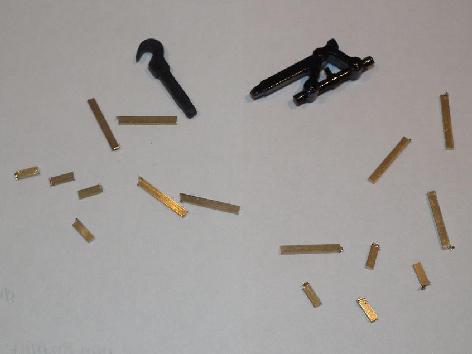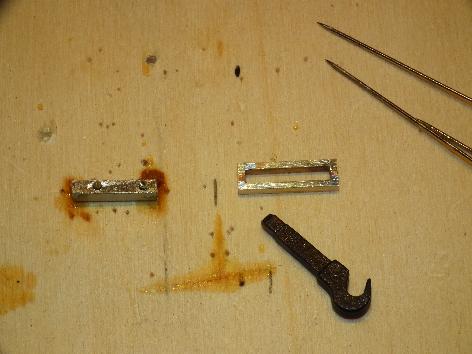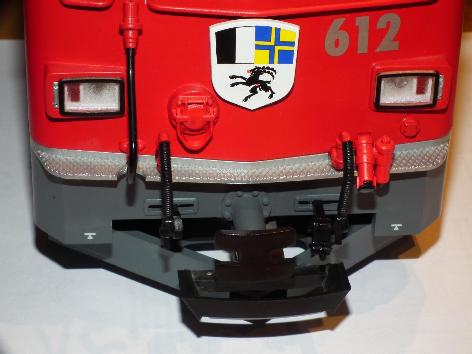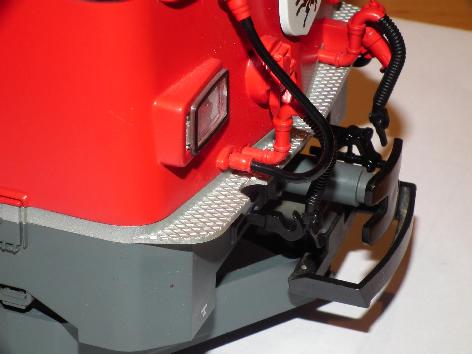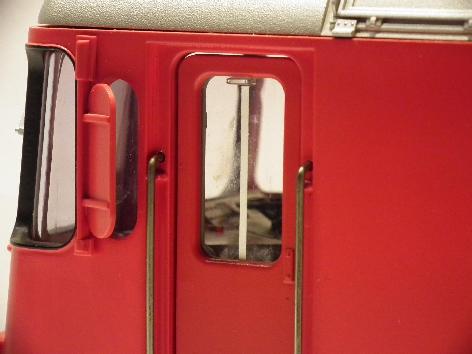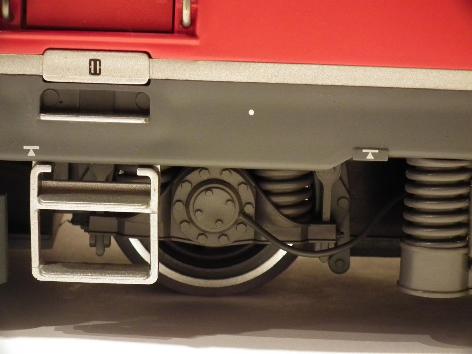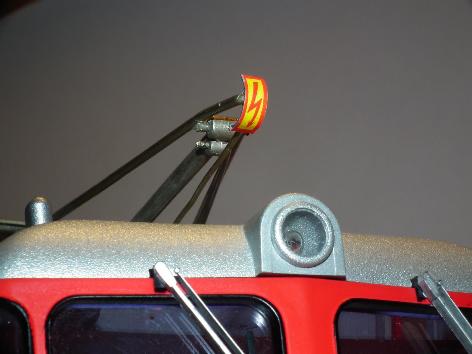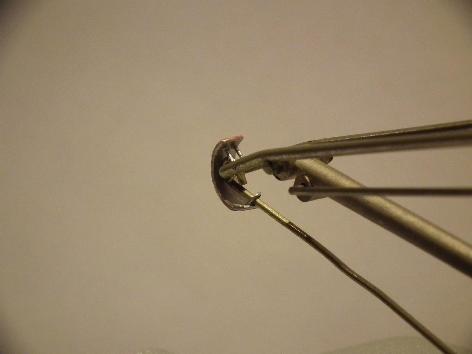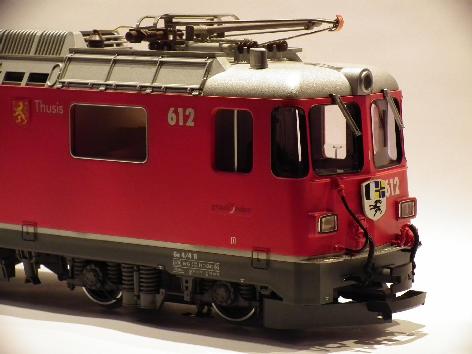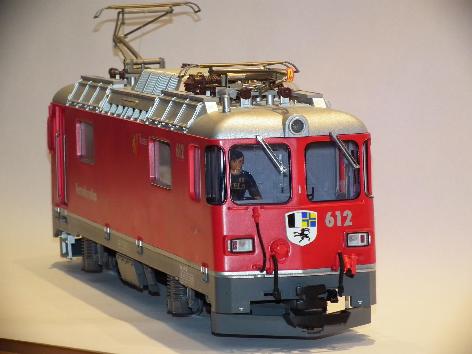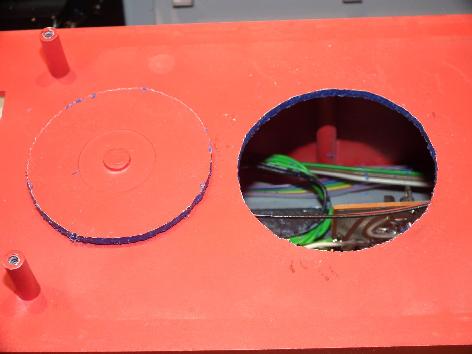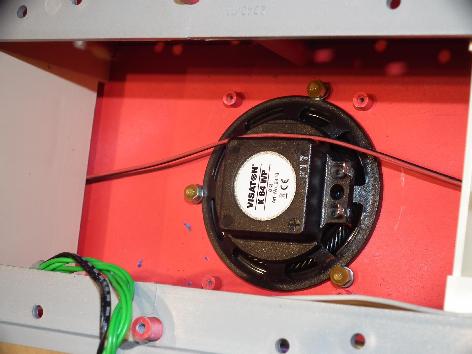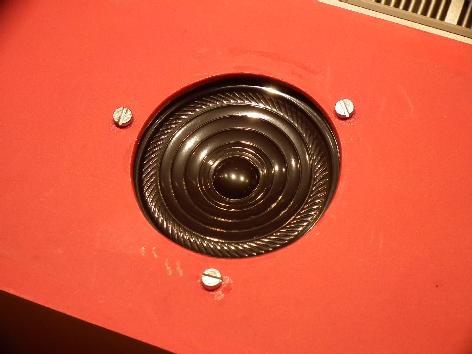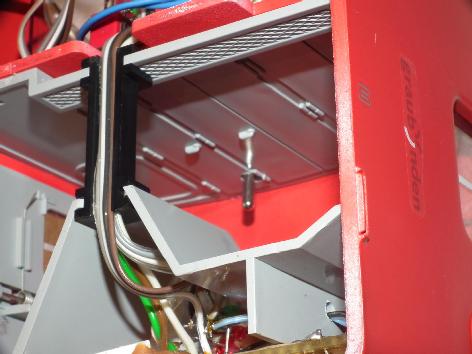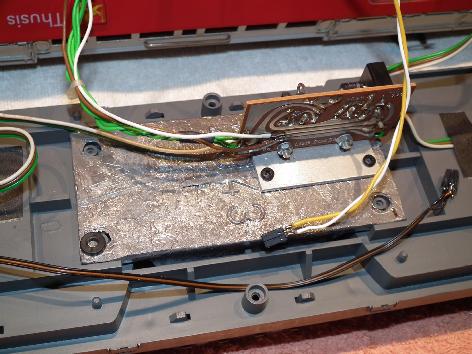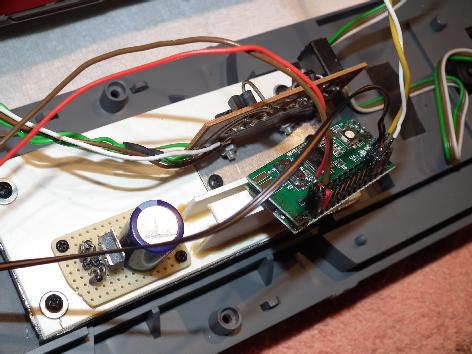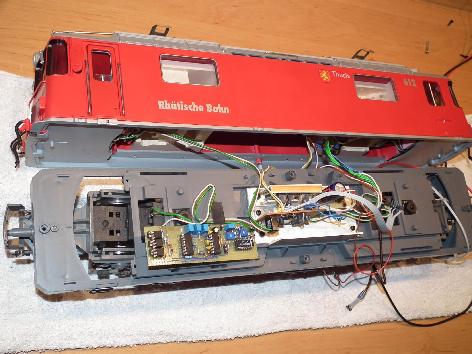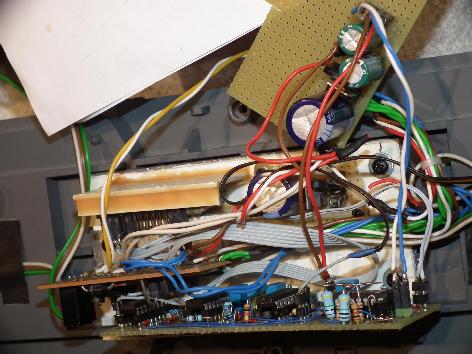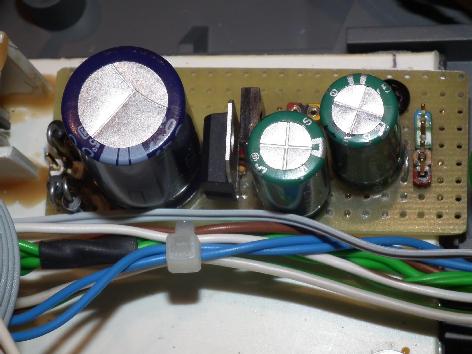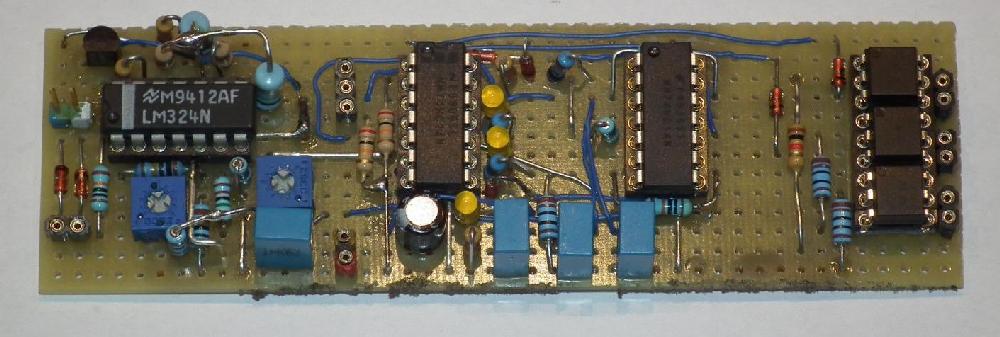Katzhagen modeling department
New chromatics - green + blue = red
For quite a while I had liked the idea to have a red RhB Ge 4/4 II, but never made a decision to really buy one. But then, a nice coincidence blessed me with a spare blue body shell of this loco's AROSA incarnation.
This body shell which featured the facelift of the rectangular head lights was subject to be revarnished in red and should be a perfect supplement to my second green Ge 4/4 611 ...
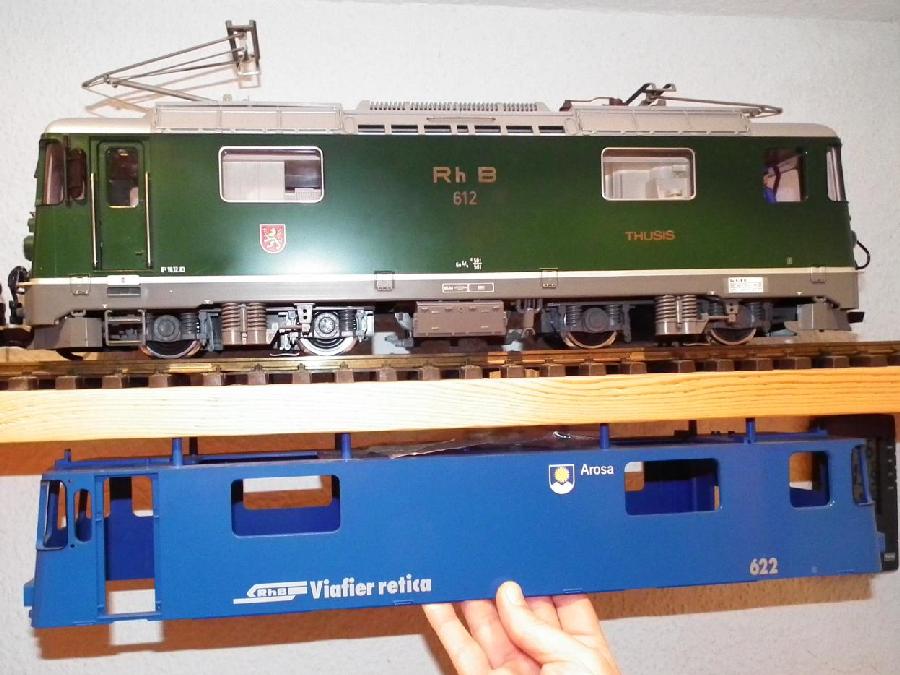
A first comparison showed that both the old chassis and the old roof should fit with the new body shell.
The metamorphosis
was meant to result in a red "Thusis". Keeping both the loco's name and number was sort of a must since it was one of my first electric locos. When I bought it in summer 2000, I had to drive 900km because it was out of production since a long time and therefor not available in any shop any longer. Furthermore, I rode on a train pulled by the facelifted prototype from Davos to Filisur in summer 2010. The photo taken during this tour was quite helpful when making the new lettering.
Prior to applying the new lettering, the old lettering had to be removed from the blue housing which then had to be varnished in red...
was meant to result in a red "Thusis". Keeping both the loco's name and number was sort of a must since it was one of my first electric locos. When I bought it in summer 2000, I had to drive 900km because it was out of production since a long time and therefor not available in any shop any longer. Furthermore, I rode on a train pulled by the facelifted prototype from Davos to Filisur in summer 2010. The photo taken during this tour was quite helpful when making the new lettering.
Prior to applying the new lettering, the old lettering had to be removed from the blue housing which then had to be varnished in red...
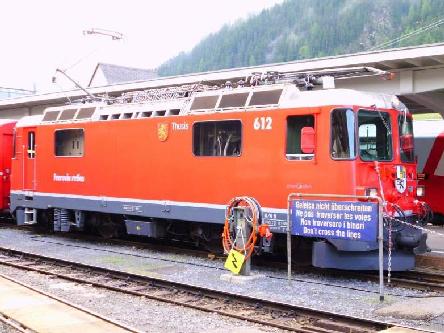
The prototype Ge 4/4 II "612 Thusis" in Davos in July 2010.

Removing the lettering with a proven Method - brake fluid
The brake fluid has to act upon the surface for some minutes before it is wiped off. Dabber print remover can be used instead of the brake fluid, which according to other opinions is said to be more convenient. In opposite to previous experiences the Arosa housing's lettering proved to be extremely resistant and the procedure had to be repeated three times.
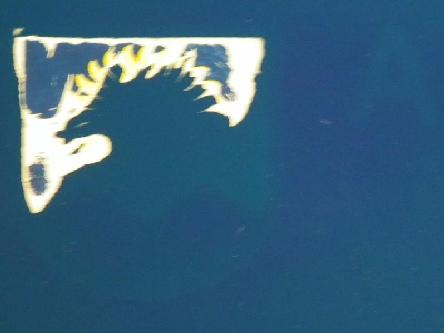
The coat of arms after its first treatment...
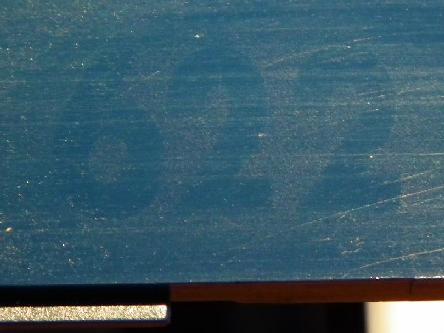
Shades of the past - the number is hardly recognizable now
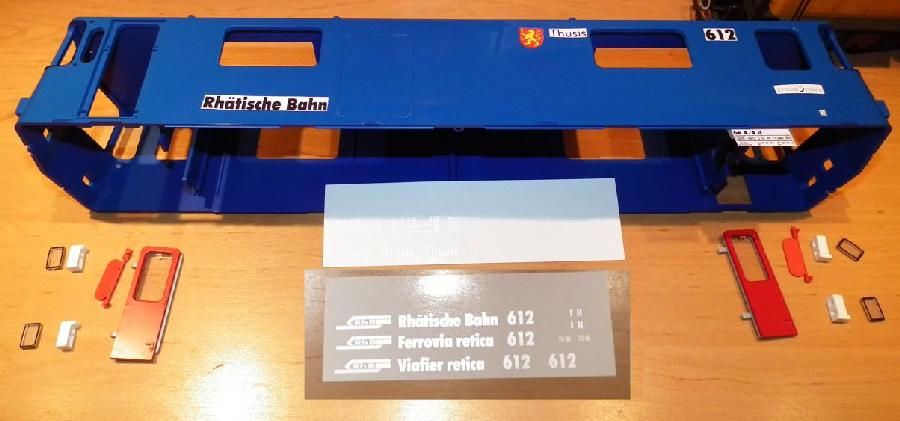
Roll call prior to the attack: Complementary parts as well as test and final lettering
Murphy
came to visit when I applied the basic colour after the body shell had been sanded. Since "Revell Basic Colour" from a spray can delivered excellent results several times in the past, I also used it this time. But this spray can was a tough one... it began to puke and then it spit its whole contents onto the housing at once - due to a defective nozzle. Twenty hours of carefully sanding was the only way to remove the debacle.After reapplying the basic colour the body shell got its first red paint:
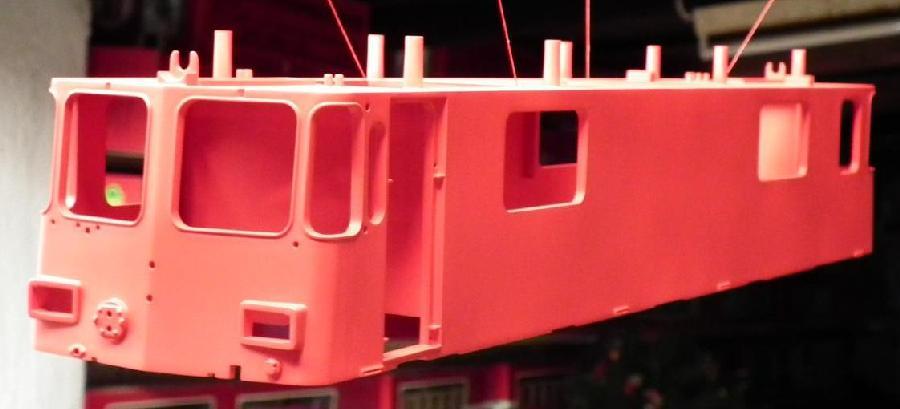
The loco's body in its new red clothes. The suspension at eye level has real advantages when using an airbrush gun.
The lettering was up next after finishing the red varnish. First the places where the decals had to be applied were carefully sanded with a grid of 3200 and 8000 in order to provide an absolute plane surface for the decals.
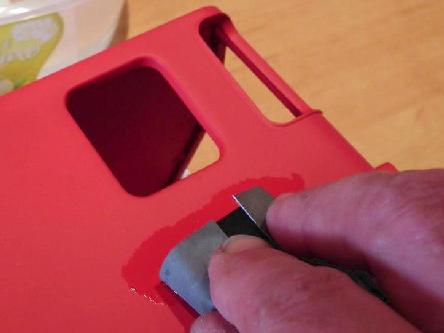
Preparation of the surface for the decals
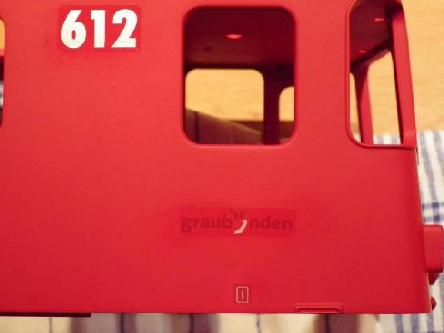
Decals at the side of one of the driver's cabs
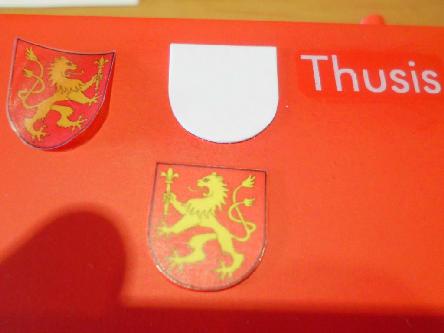
Crumbling toner and a dark surface give a headache...
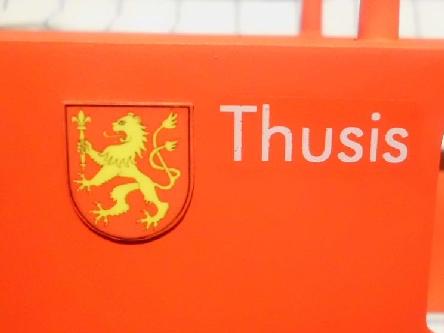
... which could be cured quite easily (see text on the right below).

The body shell after the decals' application. It also already got a finish of clear varnish - matte and glossy, 2:3
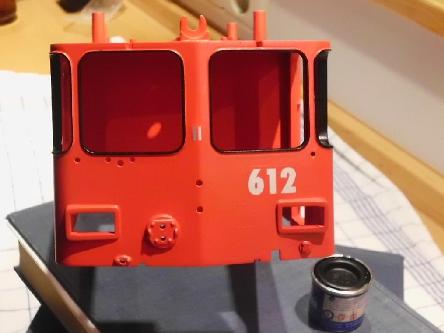
Windows frames painted in satin black - looks a bit more like the prototype
The coat of arms was a minor problem since the toner crumbled off the
edges when cutting it out and the yellow-gold lion almost vanished on the
more or less dark surface. This was solved by setting the printer to
"print on transparency" and using a thin white 0.5mm polystyrene plate which
was cut to shape as a base for the coat of arms. The latter even matches
the prototype which also has a raised coat of arms.
After the body got its finish consisting of two parts matte and three parts glossy clear varnish, the window frames were painted in satin black. This results in a startling similarity to the prototype. Of course, even better were correctly formed window panes...
After the body got its finish consisting of two parts matte and three parts glossy clear varnish, the window frames were painted in satin black. This results in a startling similarity to the prototype. Of course, even better were correctly formed window panes...
Swapping the body shells
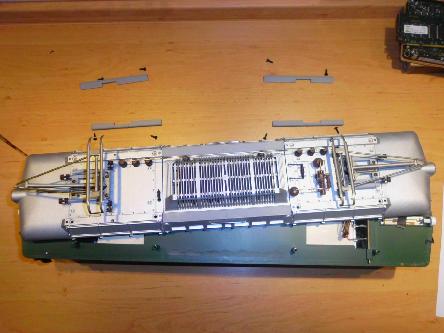
Removing eight screws beneath the roof's footboards...
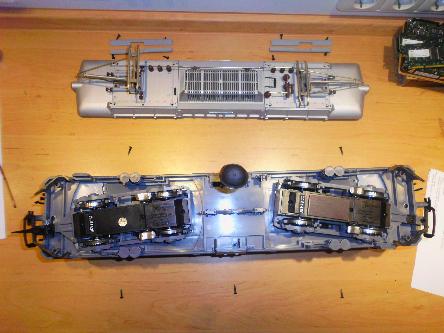
... and further eight screws at the chassis
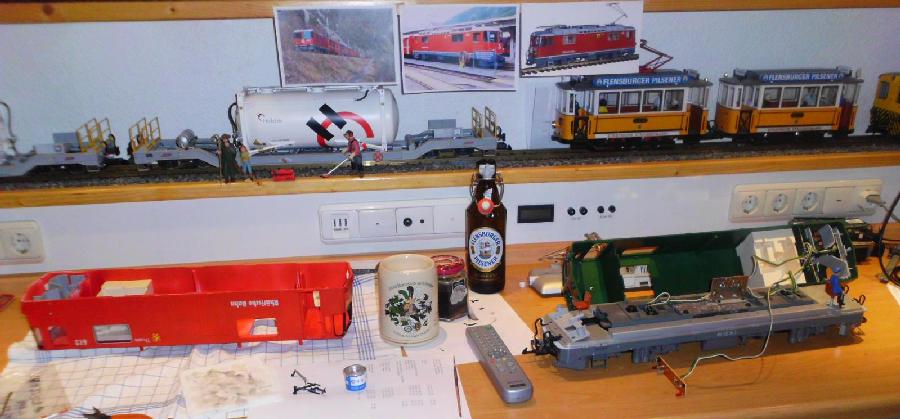
Just like an after work party - flawless swap of housings

A new circuit board for the head lights.
Due to the different shape of the front area a new circuit board for both the head and tail lights had to be made. A 2.54mm grid plate was used for the replication of the required simple circuit consisting of two diodes and a series resistor. The raster size allowed for an exact placement of both the bulbs and the LEDs.
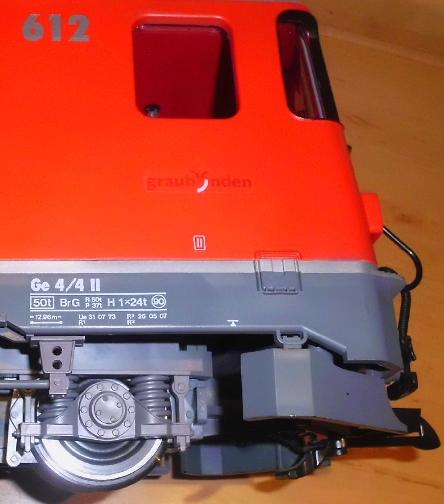
Lettering detail - technical specifications
The efforts' result
won't be garnished with further prose - the pictures do speak for themselves: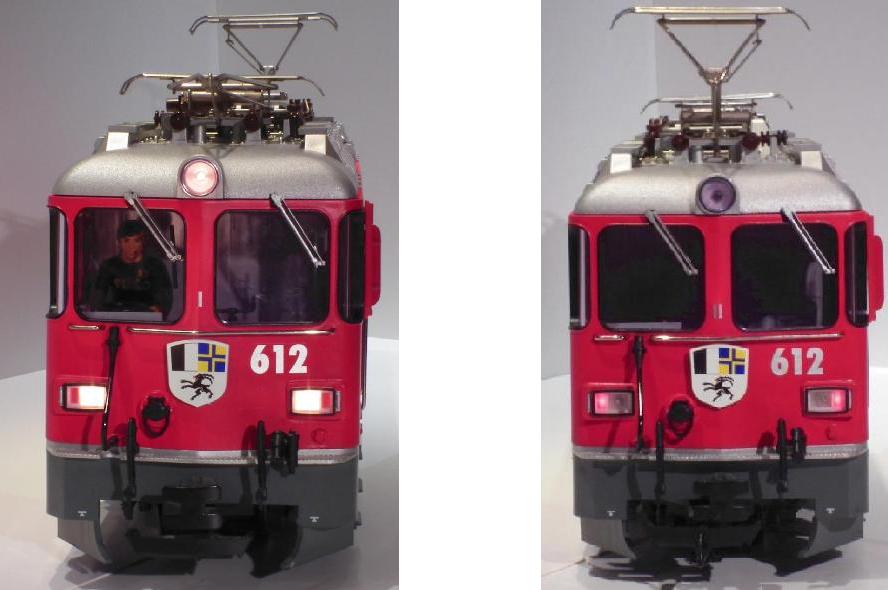
The small parts weren't painted red so that they can be used with the original green housing again (perhaps some time in the future).
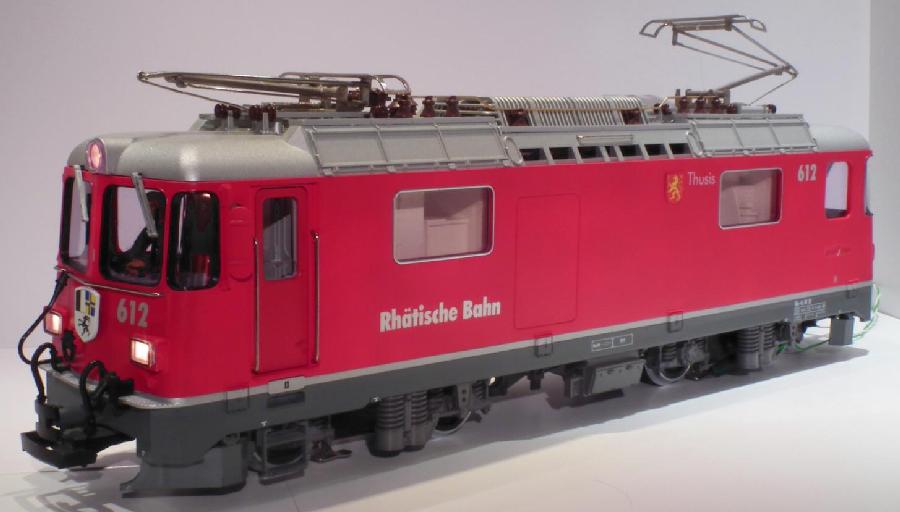
The result compensates for the basic colour debacle
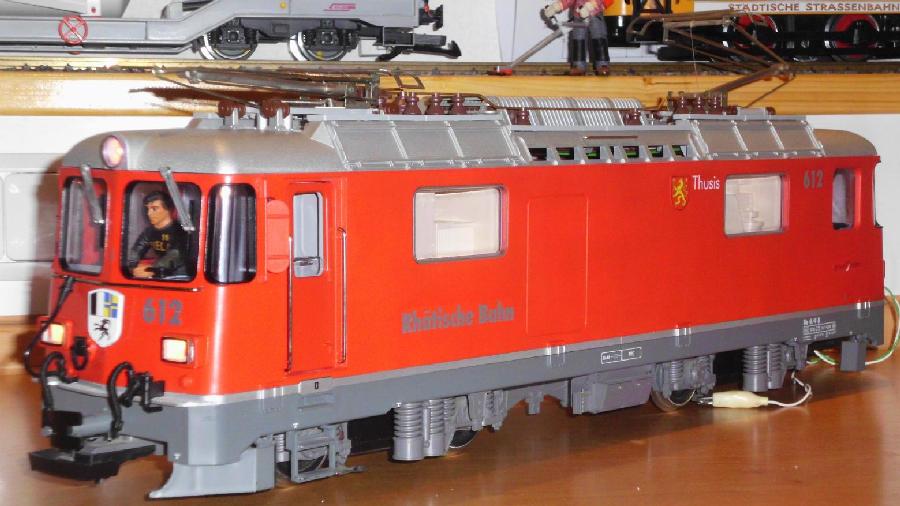
The prussian railcar driver which originally was put onto the driver's seat by Lehmann went on retirement...
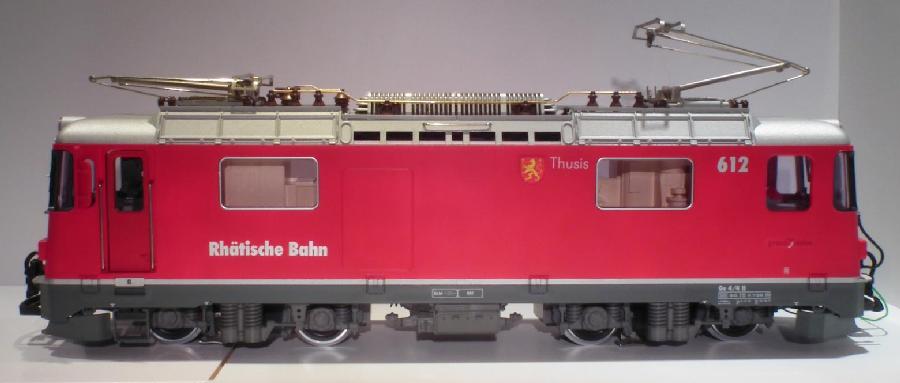
Conclusion:
This was a simple method to get a model which had been on the list of wishes for quite a long time -
at next to no costs and with lots of fun.
But the story wasn't complete...
... since the control panels inside the Thusis' driver cabs were a little bit dismal compared to the later Landquart and because it had no parking lights due to lacking a motor disconnection switch.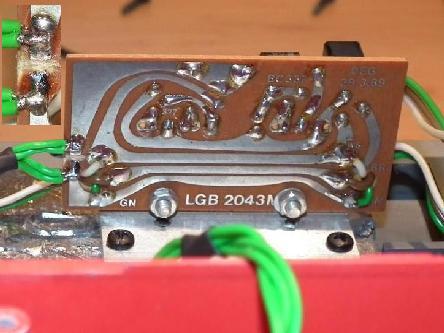
The cables connect the switch to the board's cut traces.
Parking light
Thanks to the old engine's quite simple electric configuration it wasn't much of an effort implementing a motor deactivation.Just one of the lines feeding power to the motors had to be cut and a switch had to be looped-in. The most simple method to achieve this goal was to cut a trace on the little board screwed to the chassis and to connect the open ends to a mini toggle switch (125V DC, 5A is more than sufficient) mounted on the second driver's cab rear wall.
This way the engine can be parked on the tracks at any voltage with enabled lights but without starting...
A more detailed description of this little modification can be found in the archive.
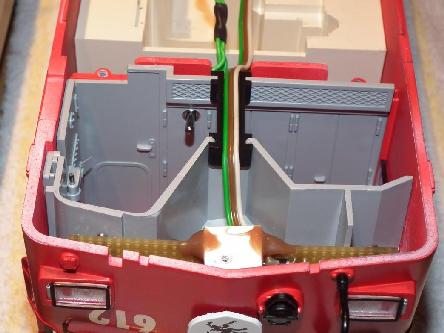
The switch ekes out its inconspicuous existance inside the second driver's cab.
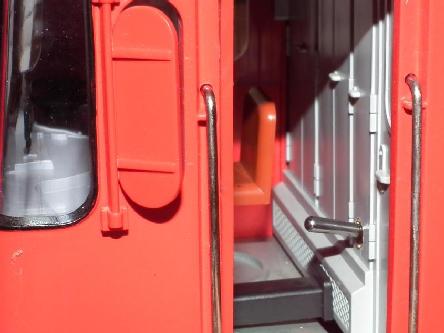
Insight into the second cab after this little operation was finished
The control panel
was brought to life with a little paint and a few LEDs (move the mouse pointer onto the picture on the right !).
First holes for the LEDs were drilled, then the paint was applied and finally the LEDs were mounted. The power supply designed for this purpose feeds two normal and three blinking LEDs in the front cab and one LED in the rear cab depending upon the engine's direction starting at a track voltage of 3.5V. The ribbon cables connecting the LEDs to the little board were equiped with plug-in contacts for trouble-free maintenance. The board was mounted on the inner side of the second cab's rear wall.
The circuit diagram :
was brought to life with a little paint and a few LEDs (move the mouse pointer onto the picture on the right !).
First holes for the LEDs were drilled, then the paint was applied and finally the LEDs were mounted. The power supply designed for this purpose feeds two normal and three blinking LEDs in the front cab and one LED in the rear cab depending upon the engine's direction starting at a track voltage of 3.5V. The ribbon cables connecting the LEDs to the little board were equiped with plug-in contacts for trouble-free maintenance. The board was mounted on the inner side of the second cab's rear wall.
The circuit diagram :
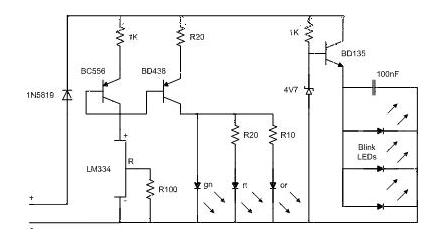
Two of these circuits are required - one per direction.
The board (on the right) features two of the shown circuits and provides for a directional illumination of the control panels.

Dashboard in action:
Display larger view
To complete the upgrade...
several small parts had to be repainted due to a wrong colour compared to the prototype. Ergo these parts were dismounted and processed accordingly. Since the airbrush gun was filled with the RhB-red now, the related small parts of the Ge 4/4 III 641 were varnished as well.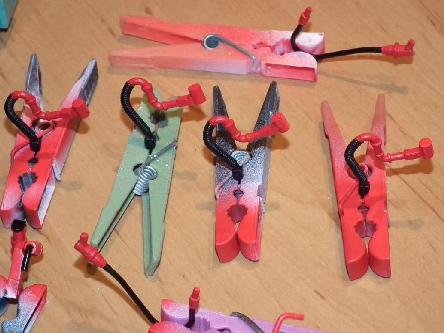
Pneumatic pipes and electrical components of the RhB Ge 4/4 II
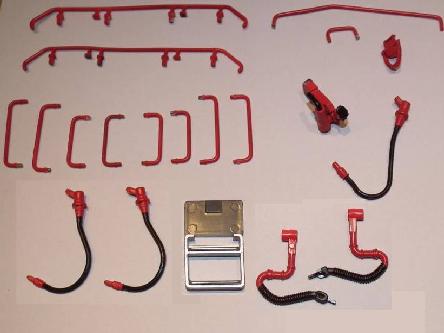
Same as on the left, in addition some parts of the Ge 4/4 III 641 Maienfeld
After dismounting the small parts they first were cleaned thoroughly with
soap sud to remove remnants of fat or dirt - a must before applying any
paint. In the face of the small parts' surface texture applying a prime
coat seemed to be a good idea. Again Revell's Basic Color was used for this
purpose - with a good result as usual.
In view of the numerous parts it appeared too laborious to build an appliance for varnishing the parts at once. Because all of the parts at least had one spot which needn't to be varnished, pegs were used as holders for airbrushing and drying.
After having applied the new paint, a long period of time for drying followed which prevented leaving any dents in the new paint when remounting the parts...
In view of the numerous parts it appeared too laborious to build an appliance for varnishing the parts at once. Because all of the parts at least had one spot which needn't to be varnished, pegs were used as holders for airbrushing and drying.
After having applied the new paint, a long period of time for drying followed which prevented leaving any dents in the new paint when remounting the parts...
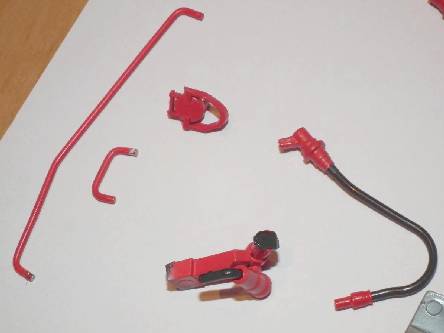
Handrails, connection elements and outlet cover
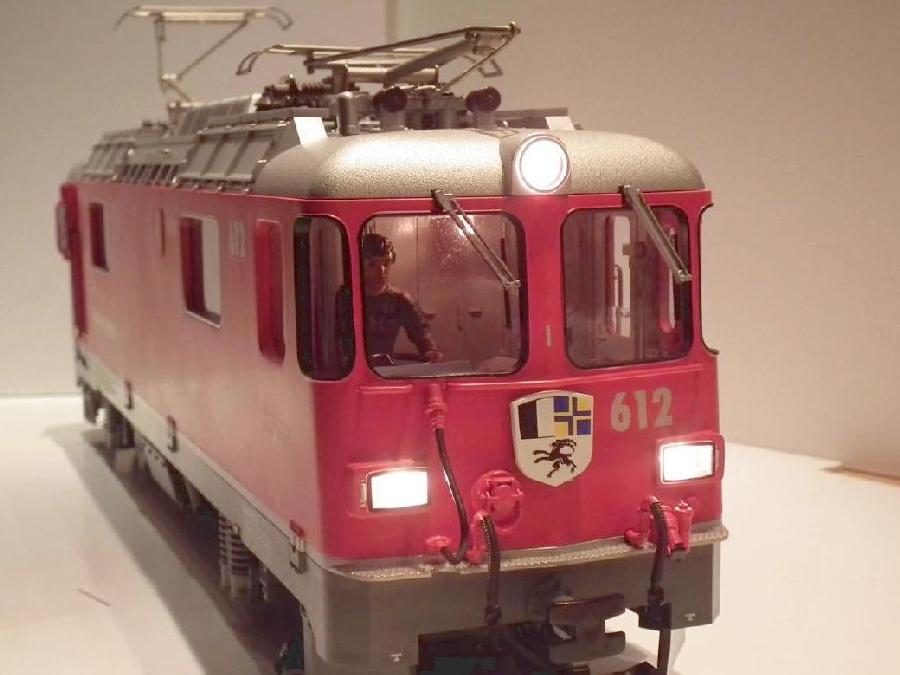
The new face of the RhB Ge 4/4 II 612 Thusis which was painted according to its prototype looks more homogeneous now compared to its prior look.
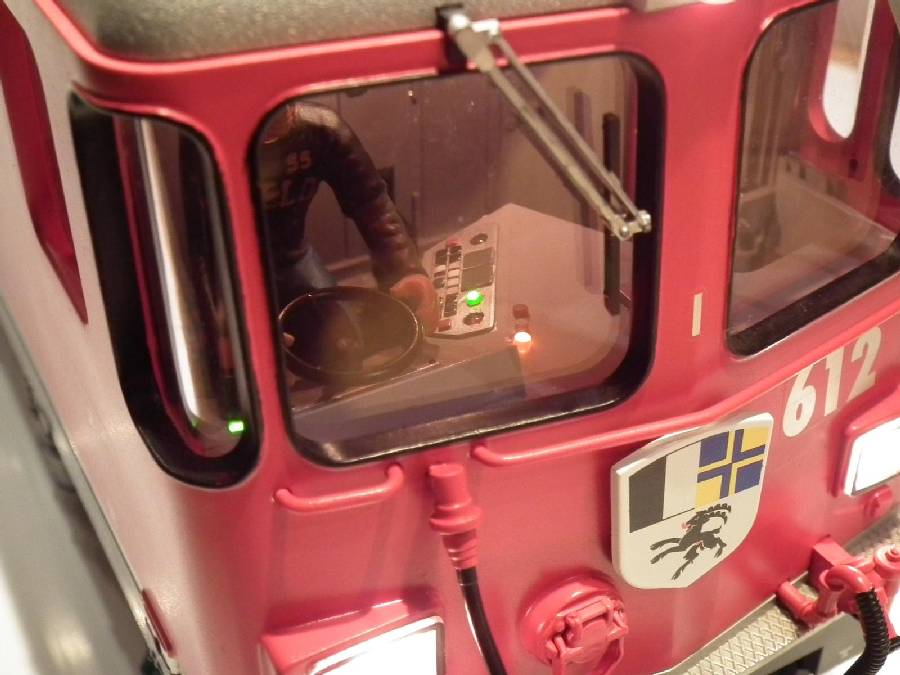
Insight into the driver's cab with pimped dashboard and front details.
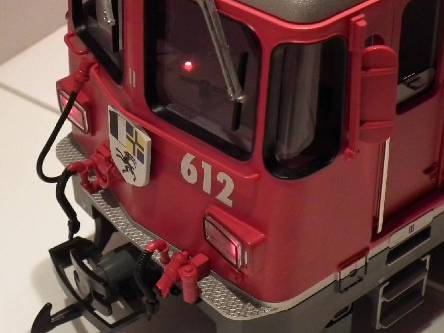
Rear view - the cabin remains dark apart from a single control light.
Remounting the airbrushed parts was basically a simple task due to the
circumstance that they just needed to be plugged into their positions.
However some of the parts had to be pushed into their position with a bit of
force cautiously, since some of the holes became tight fits because of the
parts' paint.
But goodness knows...
... and abracadabra ...
So much for...
some more or less simple modifications which helped to make this engine look a bit more like its prototype and which didn't require too much ado.But goodness knows...
... and abracadabra ...
Some rectangular brass profile (2x1mm) and a fewConversion parts helped the modell get its hooks and screw couplings...
Futher details like safety marks on the windows and sensor cables at the axle bearings require simple means only.
Some more ado is inevitable with making the warning signs for the pantographs which were made from brass.
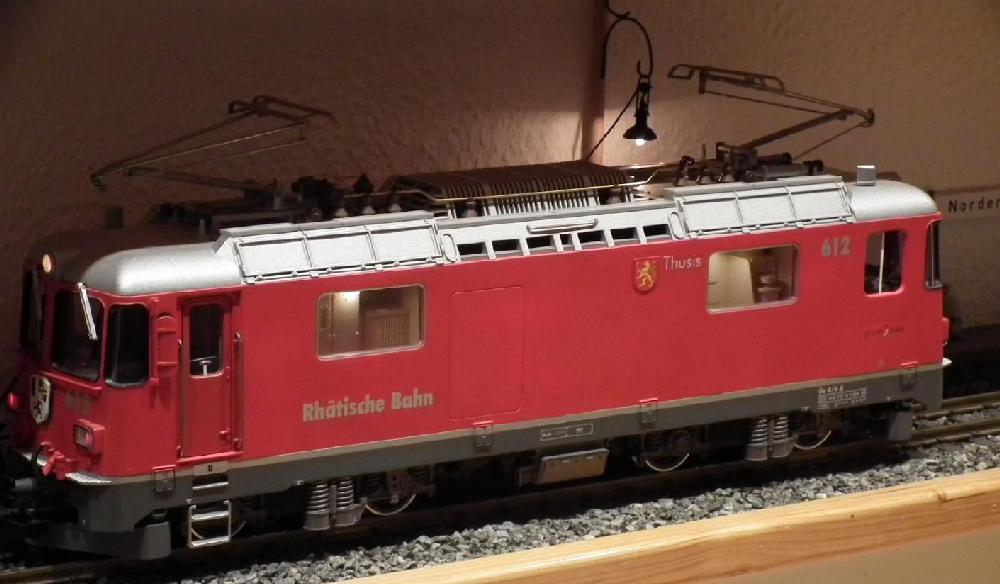
And there still was the issue with adding sound to the old dog...
A home for the speaker was found inside the roof beneath the ventilation grilles. The sound's switch was placed on the wall of the second cabin.
Since the model from the early 1990s features just very few electronics there is sufficient space for mounting sound electronics. An insulation was added to the metal before mounting the MP3 player and its power supply. This looks manageable - doesn't it ?
Silly enough, the reed switches didn't trigger the whistle sounds in real operations. Cause: The magnets mounted on the tracks issue two pulses - one each when entering and leaving the magnetic field. The MP3 player interprets this as "start sound" and "stop sound".
Hence a more sophisticated solution was required...
Since quite some electronics were required to trigger the whistle sounds the t's were crossed and the i's dotted. The board shown above (the pictures show various experimantal stages) on the one hand normalizes the reed switches' pulses so that the MP3 player can make use of them and on the other it triggers a further input of the MP3 player for playing stop and shutdown sounds. It also features a reset logic for the MP3 player which does not like slowly increasing voltage.
The picture on the left shows the power supply with two 2.7V/5F super capacitors which allow for playing the shutdown sounds after the locomotive has reached a powerless section of the tracks.
Clicking onto the picture of the controller boards final version below opens its circuit diagram.


